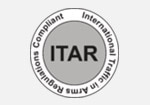Wire insulation is a crucial outer layer applied to wires and cables to protect the wires from external conditions. The insulation or jacket simultaneously prevents current from leaking from the wires into the surrounding area. To meet the needs of a diverse range of wire materials, settings, and applications, wire insulation is available in a variety of types and materials.
Materials Commonly Used for Wire Insulation
Depending on the application, wire insulation can be composed of many different materials, including plastic, rubber, and fluoropolymers.
Plastic
Plastics exhibit a number of useful characteristics ideal for wire insulation, including ductility, electrical resistance, UV resistance, and fire resistance. Below are popular plastics used in electrical wire insulation:
- Polyvinyl Chloride (PVC): PVC is one of the most commonly used insulation materials due to its cost effectiveness and high durability. It exhibits high resistance to fire and chemicals, and can maintain its shape and durability in temperatures from -55° C up to 105° C.
- Semi-Rigid PVC (SR-PVC): SR-PVC can withstand abrasion and has a high level of resistance to acids, alkalis, water, and heat.
- Plenum Polyvinyl Chloride (Plenum PVC): Plenum PVC is engineered with greater fire resistance for fire-rated use in plenum spaces.
- Polyethylene (PE): PE is denser and harder than PVC. It is highly electrically insulative and especially resistant to cracking at temperatures between -65° C and 80° C.
- Polypropylene (PP): Polypropylene has higher temperature resistance than PE, with operating temperatures between 30° C to 80° C.
- Polyurethane (PUR): PUR is flexible, with high water, chemical, and abrasion resistance. It provides excellent performance in marine applications and low temperatures from -62° C to 93° C.
- Chlorinated Polyethylene (CPE): CPE is a cost-effective insulation with excellent resistance to oil, heat, and outdoor conditions.
- Nylon: Typically used as a secondary insulator over softer insulation materials. Nylon provides a flexible protective layer with poor water resistance.
Rubber
Rubber materials are more flexible than plastic, especially at lower temperatures. Rubber materials used for wire insulation include:
- Thermoplastic Rubber (TPR): TPR is resistant to a broad range of temperatures, UV radiation, and wear.
- Neoprene (Polychloroprene): Neoprene exhibits superior abrasion and cut resistance, as well as resistance to oils and solvents.
- Styrene Butadiene Rubber (SBR): SBR has greater temperature resistance than neoprene, and is typically used for MIL cables at temperatures from -55° C to 85° C.
- Silicone: Valued for its high flexibility, silicone has exceptional flame retardance and heat resistance up to 180° C.
- Fiberglass: Fiberglass is used for extremely high temperature applications up to 482° C. It is also resistant to chemicals and water.
- Ethylene Propylene Rubber (EPR): EPR is very resistant to heat, oxidation, water acids, alkalis, alcohol, and electrical currents.
- Chlorosulfonated Polyethylene (CSPE): Perfect for low-voltage applications, CSPE has good chemical and UV resistance, and operates at a broad range of temperatures.
- Ethylene Propylene Diene Monomer (EPDM): EPDM has low conductivity, is extremely flexible, and performs at temperatures between -45° C and 177° C.
Fluoropolymer
Fluoropolymers are polymers that are especially resistant to bases, acids, and solvents. Popular fluoropolymers used in electrical insulation include:
- Perfluoroalkoxy (PFA): PFA is an excellent option for enhanced electrical efficiency due to its low dissipation factor. It can withstand temperatures from -65° C to 250° C, but is pricier than other insulation options.
- Polytetrafluoroethylene (PTFE): PTFE offers exceptional resistance to oil, chemicals, heat, and moisture. It is highly flexible in a broad range of temperatures, from -73° C to 204° C.
- Fluorinated Ethylene Propylene (FEP): FEP has excellent electrical insulation properties, as well as UV and chemical resistance. It is extremely tough and flexible.
- Ethylene tetrafluoroethylene (ETFE): ETFE exhibits excellent corrosion resistance, a high melting temperature, and superior resistance to chemicals, electrical current, and high-energy radiation.
- Halar® ethylene chlorotrifluoroethylene (ECTFE): A melt-processable polymer that exhibits superior strength, chemical resistance, and flexibility, ECTFE can also be extruded and braided for extra abrasion protection.
- Polyvinylidene Fluoride (PVDF): PVDF is an economical insulation that is lightweight, flexible, and flame resistant to UL 910 standards for plenum cables.
Wire Insulation Applications
The type of material used for wire insulation is largely determined by the application for which it is used.
Plastic wire insulation is used for:
- Medical applications
- Food & beverage industry
- Military purposes
- Industrial power plants
- Interior spaces either beneath raised floors or above dropped ceilings
- Marine and low-temperature environments
- Power & control cable applications
- CPE cable insulation displays
Rubber wire insulation is used for:
- Heat treating
- Glass and ceramic kilns
- Foundries
- Aluminum processing
Fluoropolymer wire insulation is used for:
- Military applications
- Automotive industry
- Household appliances
Premium Wire Insulation From Electro-Prep, Inc.
At Electro-Prep, we have the knowledge, equipment, and skills necessary to produce quality wire and cable insulation from a variety of materials for virtually any application. Contact us today to learn more about our selection of insulation materials or request a quote.






